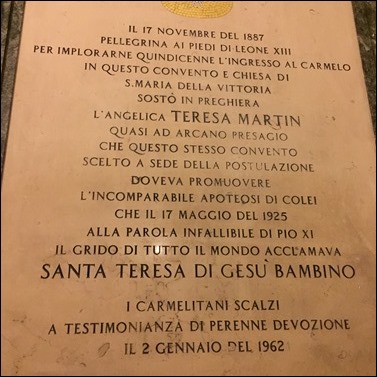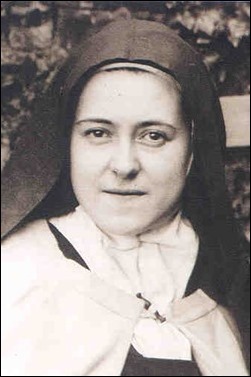Hello and welcome,
I want to begin this week by expressing our deep concern for those impacted by Hurricane Matthew, both in the Caribbean and here in our own country.
We are watching the situation very closely, and are particularly troubled by the reports of devastation and the rising death toll in Haiti. I have authorized a special collection at all parishes in the archdiocese next weekend (October 15-16) to aid in relief efforts for this developing need.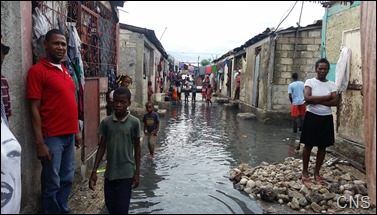
I ask you to join me in praying for all affected by this powerful storm, and in a special way for those who may still be in harm’s way and for the first responders who imperil their lives to bring aid to others.
– – –
This week, I joined the other diocesan bishops of Massachusetts in issuing a letter urging voters to oppose Massachusetts Ballot Question 4. At a time when overdose deaths from opioid drugs are at an all-time high in Massachusetts, we are confronted with this referendum that would legalize the recreational use of marijuana, which is definitely a gateway drug and could cause great damage, particularly to young people. I’d like to share it with you here:
Marijuana represents a significant part of substance use in America and adversely affects the health of millions of Americans. According to a recent report issued by the National Institute of Drug Abuse, Marijuana is the most commonly used illicit drug in the United States. Its widespread use and abuse, particularly by young people under the age of eighteen, is steadily increasing while scientific evidence clearly links its long term damaging effects on brain development. “When marijuana users begin using as teenagers, the drug may reduce thinking, memory and learning functions and affect how the brain builds connections between the areas necessary for these functions. Marijuana’s effects on these abilities may last a long time or even be permanent.”
Legalizing a drug for recreational use that causes these effects on the human body, particularly our youth, is not a path civil society should choose to take. It has been well documented in Massachusetts and across the country that the nation is currently waging a losing battle against opioid abuse. Our attention must not be diverted from that health crisis, nor do we want to add fuel to it by contributing to the risks for the use of other illegal/illicit/proscribed substances through the legalization of marijuana. The availability of marijuana for adolescent users already constitutes an environmental factor for the later use of other illicit drugs. Its legalization will only serve to worsen this problem.
One only has to examine the devastating impact felt in Colorado since 2013, when recreational use of marijuana was legalized, to fully grasp what would be in store in Massachusetts. A comprehensive report issued last month by the Rocky Mountain High Intensity Drug Trafficking Area states that, since marijuana has been legalized, traffic deaths have increased by 48 percent. Recent statistics show that of all traffic deaths in Colorado, 21 percent of those individuals killed tested positive for marijuana. Marijuana related hospitalizations in Colorado have doubled from 2011 to 2014.
Marijuana use and abuse by the youth of Colorado has increased by 20 percent since legalization. Young people in Colorado rank first in the nation for marijuana use — an illegal activity for anyone under the age of 21. Strikingly, this has negatively affected their family life, social life and school performance where expulsions and drop-out rates have spiked significantly. Do we really want to bring these issues to Massachusetts?
The Catholic Church teaches “the use of drugs inflicts very grave damage on human health and life. Their use, except on strictly therapeutic grounds, is a grave offense.”
The Roman Catholic Bishops of Massachusetts join Governor Baker and many other elected officials along with the American Academy of Pediatrics (AAP) and the American College of Pediatricians (ACP) in opposing the legalization of marijuana. We urge the voters of Massachusetts to vote NO on Question 4 on November 8, 2016.
Cardinal Seán P. O’Malley, OFM, Cap., Archbishop of Boston
Most Rev. Robert J. McManus, Bishop of Worcester
Most Rev. Mitchell T. Rozanski, Bishop of Springfield
Most Rev. Edgar M. da Cunha, SDV, Bishop of Fall River
– – –
Now, on to the events of my week…
As I left off last week, I was in Rome celebrating the ordination of transitional deacons from the North American College at St. Peter’s Basilica in Rome.
Friday, the day after the ordinations, I celebrated a Mass in honor of St. Thérèse the Little Flower at my titular church in Rome, Santa Maria Della Vittoria, which is very famous for its statue of St. Teresa of Avila by Bernini. 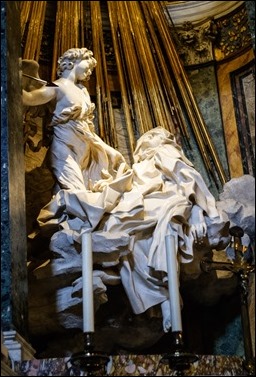
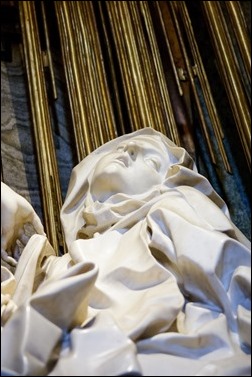
As I mentioned last week, this is the church that St. Thérèse visited on her pilgrimage to Rome as she was about to ask the pope for permission to enter the convent.
At the Mass, I was joined by a number of priests from Boston who were in Rome for the ordinations of our transitional deacons. Also with us was our new transitional deacon, Deacon Kevin Leaver, who proclaimed the Gospel in Italian and assisted at the altar.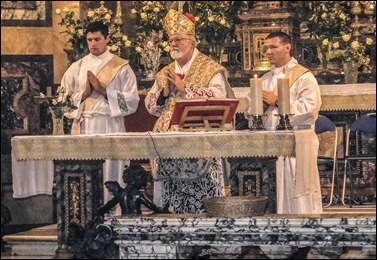
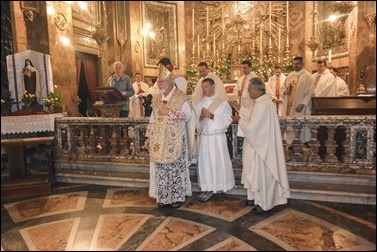
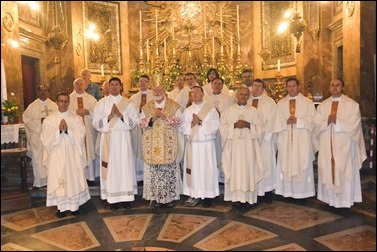
The Carmelite friars who run the church were very gracious in organizing liturgy, and afterwards they invited all the American priests for a dinner in their friary.
I’d like to share the English translation of my homily from the Mass with you here:
In 1887 Louis Martin took his daughters Celine and Thérèse on a diocesan pilgrimage to Rome to mark the Golden Jubilee of the priestly ordination of Pope Leo XIII. In many ways it was like a grand tour for the girls. About one fourth of the pilgrims were from the nobility and others from very prosperous bourgeois families. The pilgrimage lasted over a month, they traveled by train and stayed in the finest hotels; they visited Milan, Venice, Padua, Bologna, Assisi, Naples, Florence, Pisa, Genoa. But the highlight of the trip was the visit to Rome and the audience with the Holy Father. This is where we see that despite all of the glorious splendor of the trip, Thérèse was focused on her vocation, her desire to give herself to the Lord as a Carmelite nun.
For that reason the young Thérèse visited this church during the pilgrimage, certainly because of the famous Bernini statue of her patroness, St. Teresa of Avila and also because of the presence of the Carmelite Friars. Her feast day has become one of the most important annual celebrations in this community. St. Thérèse and her family also visited the Coliseum where the young Thérèse climbed over a fence so that she could draw near and kiss the stones where the martyrs shed their blood.
This plaque commemorates the visit of St. Thérèse of Lisieux to the church
On that same trip, accompanying the distinguished pilgrims and the diocesan Bishop, the young Thérèse participated in a special papal audience. Following the customs of those times, each pilgrim drew near to kiss the Holy Father’s foot, then his hand, and then remained kneeling to receive the Pope’s blessing. No one was supposed to address the Holy Father, but the young Thérèse grasping the Holy Father’s hands said: “Holy Father, in honor of your Jubilee I want you to let me enter the Carmel at 15 years of age.” The Swiss guards actually had to lift her up and carried her away. It was quite a spectacle. As a matter of fact, in 1935 Thérèse’s sister Pauline received a letter from an Italian nun stationed in Egypt that contained a delightful surprise. The nun explain that many years ago her father came home from his duties in the papal household and told the family at dinner about a beautiful French girl who had implore the Pope to allow her to enter a Carmel in France even though she was under age. He had tears in his eyes as he told the story, and the family was deeply moved as they listened. When the nun read the account in the autobiography, the book fell from her hands. She realized that the girl her father had seen was St. Thérèse.
I hope that all of us who gather here today remembering St. Thérèse’s pilgrimage that brought her to this church so many years ago, will have the same desire to give ourselves entirely to God. Here in the shadow of St. Teresa of Avila who reminds us that only God is enough, “Solo Dios basta”, let us ask the grace to live the simplicity of the Gospel, and becoming like a little child, enter the Kingdom of Heaven.
Thérèse lived in the world of Marx, Freud, Darwin, and Nietzsche, and although she had little formal education, her insights and intuition have left a legacy of wisdom and spiritual genius that has allowed so many to find meaning in life and a path to holiness.
When St. Teresa of Avila was a young girl, she wanted to run off to America with her brother in the hopes that they would be martyred by the aboriginal peoples living there. Indeed St. Teresa’s brother did go off to the New World in the service of the King of Spain, but St. Teresa did not cross the ocean to be martyred. Her mission was to reform religious life and indeed the Church in our beloved country. St. Thérèse also had great devotion to the martyrs and certainly had been exposed to the high road to holiness: strict asceticism, strong discipline, and demanding sacrifices. One needed a powerful will to storm the heights of such holiness, to be a great soul. Unfortunately, many people instead of being inspired by such a challenge, find themselves overwhelmed, incapable of attempting to measure up to these heroic standards.
St. Thérèse within the walls of Carmel quietly overthrew that spirituality. She realized that she was a little soul, and she also knew, and this is what is revolutionary about her, that she and all the other little souls like her could still be great Saints. Ahead of her time, Thérèse believed in the fundamental message of the Second Vatican Council: the universal call to holiness. Little souls, who make up the vast majority of humanity, are well aware of our limitations, our frustrations, even with small difficulties encountered every day, with spiritual poverty and inability to come close to accomplishing anything of great significance. Nevertheless, we can still have an intimate relationship with God, and our lives can have a meaning and the legacy equal to that of the great soul. The way for most people as it was for Thérèse, is not the way of greatness but the way of littleness.
Thérèse came to realize that the dramatic and severe penances that required the truly heroic spirit were not her path to holiness. Her path was to become like a little child, trusting in God, accepting life’s cross and doing the little things of everyday life, but doing them with great love. For Thérèse the little penances of accepting people’s human foibles and being kind to them was more important than some huge sacrifice which might only serve to fuel our vanity and pride.
In one of the sermons, Father Karl Rahner used a picturesque phrase that often comes back to me: “We live in a wretched little hut of our own existence.” At times we are so painfully aware of our sins and shortcomings, how mediocre we are, how unheroic and selfish, how much there is in our past that we shudder to remember. Alone in our little hut many of us could be devoured by thoughts of some of the things we have done and good things we fail to do. Thérèse, however, does not allow us to indulge in this self-pity. She is the realist of the present moment; she writes of herself: “It seems to me that love penetrates and surrounds me, each instant this merciful love renews me, purifies my soul and allows no trace of sin to remain.” She writes elsewhere, “If I committed all possible crimes, I would always have the same confidence. They would be like a drop of water thrown into a blazing fire.”
What a beautiful message for this Jubilee of Mercy. Despite our sins and limitations, God’s love and mercy engulfs us. Our heavenly Father is anxious to heal us of the wounds of our sins and receive us joyfully into his arms, like the father of the prodigal son is overwhelmed with joy when his less-than-perfect child returns home.
Few saints have touched the Catholic imagination the way that St. Thérèse has done. It is amazing that in a world that exalts activism this young contemplative nun has touched the hearts of so many. Without ever leaving her cloister, she became the patron of the missions along with St. Francis Xavier who baptized more people than anyone else since the days of St. Paul.
Thérèse on the other hand, became a missionary through her life of prayer. She understood that her vocation was to spend her life helping to save souls by praying for them. She recounts the wonderful story of how as a young girl she heard about a man called Franzini who had murdered two women and a girl and was completely unrepentant for his crimes. Thérèse prayed fervently for his conversion and seconds before his execution, the murdered grabbed the crucifix from the hands of the chaplain and kiss the wounds of Christ. When Thérèse read the account in the newspaper she was filled with such joy knowing that her prayer contributed to this dramatic conversion.
We too are called to be missionaries, to spread the Gospel, by our good example, our works of mercy and by our prayers. I once heard of a Chinese family that actually converted to Catholicism after they watched some Western visitors to their village who made the sign of the cross and prayed before they ate their dinner in a restaurant. The Chinese who had never met any Christians before, went over and asked them what that ritual was. The people took the opportunity to witness to their Catholic faith. The Chinese listened with great attention and eventually asked how they might join the Church. Grace before meals but the little way that lead pagans into Christ’s Church.
This Year of Mercy gives us a very special opportunity to live the little way of St. Thérèse by practicing the works of mercy, doing little things but with great love, at the same time praying fervently for all of those that God puts in our path.
An important part of St. Thérèse’s little way is to live the present moment. So often we are pulled down by the problems and the pains of the past. We live in the shadow of our sins and our failings. In this Year of Jubilee let us trust in God’s mercy and rejoice in his pardon. Likewise we live in a world that is often focused on the future, but we must learn to live in the present.
Thérèse knew that the past can never be retrieved, and it’s a waste of time to grieve for it. If we believe as she did that God is nothing but mercy and love, we can put our sins behind us once we have sought forgiveness, and forge past them. The deeds are part of history, but the guilt is gone even as history is gone. As for the future, only God knows what it will hold, and we may safely leave it in His hands. “The only thing we can be sure of the future is that the Providence of God will always rise before the sun”, as the great French preacher Henri Lacordaire once said. When tomorrow becomes today, God will be there to sustain us.
An American Bishop whom I knew very well, Bishop Patrick Ahern, who died in 2011 at the age of 92 was one of the principal promoters of the Church’s decision to name St. Teresa Doctor of the Church. He is the person who helped me to understand the greatness of her theology and her insights into the Gospel.
In one of his writings on St. Thérèse, Bishop Ahern speaks about a very dear friend of his father, Jim Conlan who as a child contracted infantile paralysis, polio, which left one leg a few inches shorter than the other. The heel of one shoe was built up with the lift to make up for the difference. It was a great source of suffering to him as a youth when he would go to basketball games and dances and other events and be only a spectator. One day he encountered a priest at Fordham University, an old Jesuit. The priest grabbed his arm and said: “What’s that you have there, son, polio?” Jim answered: “Yes, Father”. “Are you glad you have polio?” The priest asked. Bitterly Jim replied: “No, I’m not glad I have polio!” But the priest replied, “Let me tell you something, son. Until the day comes when you can say to God and really mean it, ‘Lord, I’m glad I have polio’, you will never amount to anything!” Without a further word the priest walked on and Jim never saw him again in this life.
At first he burned with resentment. That night he did not sleep all night. He wept and prayed; suddenly he felt that God was near. At length, he found himself saying, “Lord, I’m glad I have polio” and he knew that he really meant what he said. Years later he often recounted that story and assured people that he would’ve never become a priest if the old Jesuit had not confronted him with that statement.
I think the story is an example of the little way. What Jim did that night was to put into practice Thérèse’s doctrine of littleness, of joy and wholehearted acceptance of ourselves with all our diminishments, no matter what they are –being glad that we are who we are and have what we have. Thérèse never taught us to seek suffering. What she taught us to do was simply to love life the way it is and ourselves the way we are, to love what she called our littleness. By this she meant our poverty, our diminishment, our failures, the things we are ashamed of and wish we could do over if we had another chance. She did not hesitate to call these our riches. When her loving father literally went out of his mind and had to be committed to an insane asylum, even though her father’s illness broke her heart, she referred to the family sufferings as “our riches”.
Thérèse teaches us to accept what we cannot change, to welcome it as God’s holy will. As Bishop Ahern observed at the end of his life: “When I look back upon so many disasters, I realize that they were blessings in disguise. Without them I would not have grown but would’ve remained the selfish and vain person that I was. I dare to think that some of the best qualities in me would not be there if some of the worst things had not happened to me. Accepting all those setbacks with love puts us on the path of the little way of Thérèse.
Like the other great Doctors of the Church, St. Thérèse had insights into the Gospel that transformed her life and that she was able to articulate in order to help others find the path to sanctity.
Today in this place that was so special to St. Thérèse we ask for the grace to embrace our littleness and trustingly place our lives in God’s hands.
– – –
By Sunday I was home in Boston to celebrate the 150th anniversary Mass of St. Mary Parish in Dedham.
We had the anniversary celebration of the parish with their new pastor, Father Wayne Belschner. The church, of course, is very beautiful. Father Bill Kelly, before leaving, led the renovation efforts there.
I also complimented the parish on their promotion of vocations — a number of seminarians and consecrated women have come out of that parish.




I found the history of the parish very interesting. It was founded right after the Civil War at a time when many Irish were arriving from Ireland after the famine. Interestingly, unlike some other local communities, the local Protestants were very accepting of the Catholics. They welcomed the first Acadian French Catholics to the town in the 1840s. Then, in the 1880s, when they were building their church, one Protestant gentleman made a sizable financial contribution and another donated the stone for the structure.
St. Mary’s is a very vibrant and active parish. They are particularly blessed with a wonderful Life Teen ministry, which has made such an impact.

I was so pleased to be part of the observance of their 150th anniversary. It was a very joyful celebration.
– – –
The following day was Oct. 3 and I joined my fellow Capuchins at San Lorenzo Friary for the celebration of the Transitus of St. Francis. In all of our monasteries – as the other Franciscan brothers and sisters do — we celebrate the anniversary of St. Francis’s death. He died on Oct. 3 at the Portiuncula in Assisi.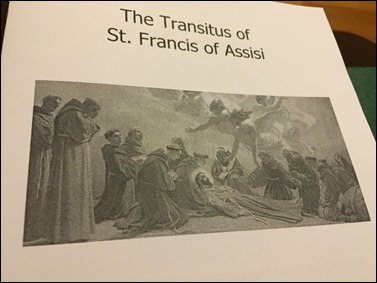
The Transitus ceremony consists of reading the accounts of his death from the ancient biographies, reading the gospel that Francis had read when he was dying, as well as the singing of the Transitus and praying Psalm 142 which Francis was praying when he died.

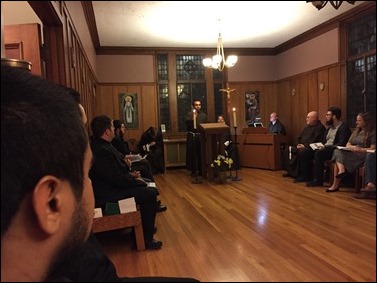


We venerate the relic of St. Francis and then, afterwards, the Friars and visitors gather for coffee and almond cookies, which are significant because, as he was dying, St. Francis asked for an almond cookie.
– – –
Of course, the next day is the Feast of St. Francis itself and on that day I celebrated Mass for the National Conference of Diocesan Vocation Directors at St. Ignatius Church in Chestnut Hill. It was an opportunity to welcome and thank the 300 vocations directors from throughout the United States who have been here for their annual convention.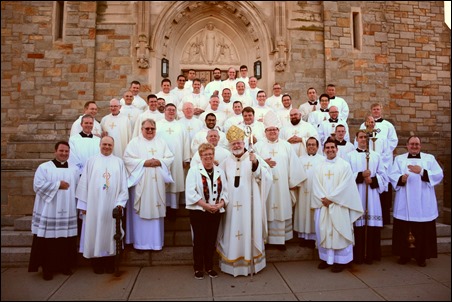
We are very grateful for their presence and very grateful for the ministry that they perform for the church — helping people discover their vocations, which is an extremely important ministry in today’s Church.
I thanked the Jesuits of the parish for hosting us, and I also reminded the people that the Jesuit General Congregation was beginning this week, and asked for their prayers.
After the Mass at St. Ignatius, the vocations directors visited St. John’s Seminary, then, the following day, they visited Pope St. John XXIII National Seminary.
– – –
Wednesday, we had one of our semi-annual meetings of the bishops of the Boston Province, which includes the four dioceses of Massachusetts along with Maine and New Hampshire and Vermont. This was our first gathering with our new auxiliary bishops, Bishop Robert Reed and Bishop Mark O’Connell. We were also very pleased to be joined by some of the retired bishops of the province, as well.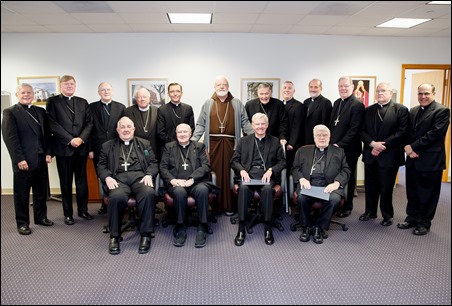
At these meetings we discuss issues that affect the Church throughout the region and try to make sure that our pastoral practices are all “on the same page,” as it were.
– – –
At our meeting, we received the sad news that Bishop Kenneth Angell, the Bishop Emeritus of Burlington, Vermont had just died. Bishop Angell had been in poor health, but we all remember fondly the times that he was with us.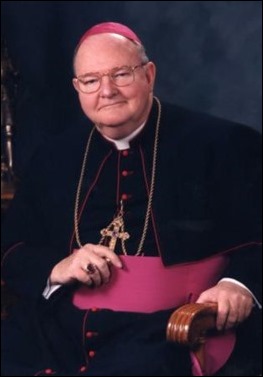
He was a very gifted pastor and preacher and also a man with a great sense of humor. His brother, David Angell, was a writer and producer of many television sitcoms, including the shows Frasier and Wings. Sadly, David and his wife Lynn were killed in the Sept. 11 attacks, but I used to always tell David that if Bishop Ken hadn’t become a bishop, he would have had some competition, because Bishop Ken was so talented, witty and had such imagination.
We pray for the repose of his soul and I plan to be at his funeral next week.
– – –
Thursday, I was visited by Father Tom Foley who was in town as part of the vocation directors meeting. He is currently serving in San Antonio as a military chaplain. 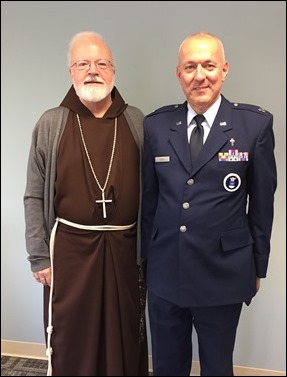 One of his tasks is recruiting, so he came home for this conference in Boston. It was wonderful to have a chance to chat with him and to see him. I was pleased to see he’s doing very well in his responsibilities as a recruiter of chaplains for the Military Services.
One of his tasks is recruiting, so he came home for this conference in Boston. It was wonderful to have a chance to chat with him and to see him. I was pleased to see he’s doing very well in his responsibilities as a recruiter of chaplains for the Military Services.
– – –
Also that afternoon, we had one of our regular meetings of the Vicars Forane of the archdiocese. I am very grateful for all the help they provide. As I told them, their task, as the Holy Father always says, is accompaniment — to accompany our priests and to work together with the Auxiliary Bishops and Episcopal Vicars. We have a very fine group of men who, in addition to their pastoral possibilities, very generously put themselves at the service of their brother priests in the vicariates.
Until next week,
Cardinal Seán

